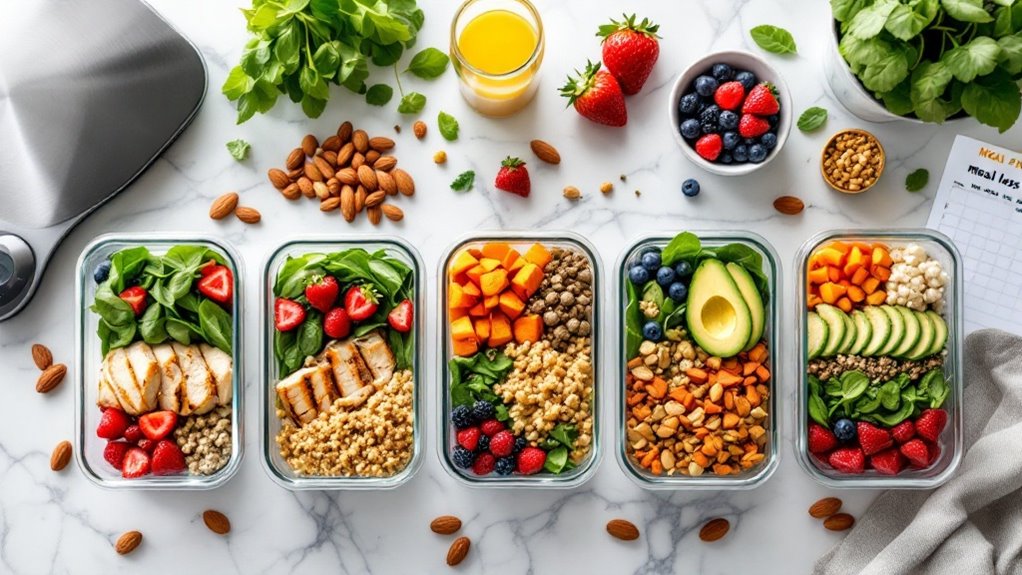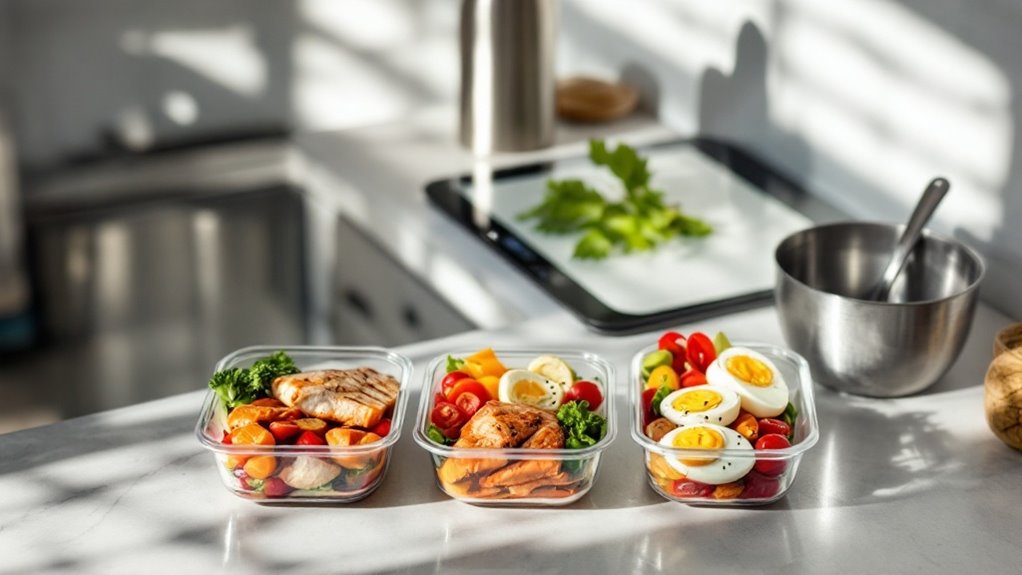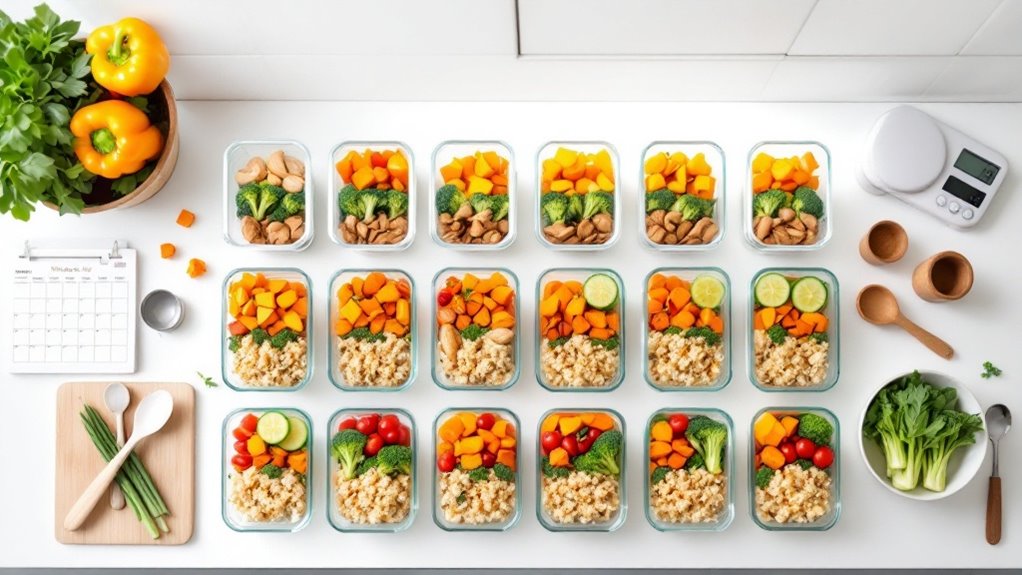Lose 15 Pounds in 2 Months

Losing 15 pounds in two months requires creating a sustainable daily deficit of 875 calories through strategic meal planning and consistent exercise. The formula combines three strength training sessions weekly with 2-3 cardio workouts at 75-85% max heart rate. A balanced nutrition plan follows the 40-30-30 ratio of lean protein, complex carbs, and vegetables. Success depends on tracking progress through weekly weigh-ins and body measurements. The journey to sustainable weight loss reveals powerful strategies for long-term transformation.
Key Takeaways
- Create an 875-calorie daily deficit through diet and exercise to achieve the 15-pound weight loss goal in two months.
- Follow a balanced meal plan with 40% lean protein, 30% complex carbs, and 30% vegetables at each main meal.
- Perform three weekly strength training sessions and 2-3 cardio workouts of 30-40 minutes at 75-85% max heart rate.
- Consume 0.8-1.0 grams of protein per pound of body weight and get 7-9 hours of sleep for optimal results.
- Track progress through weekly weigh-ins, monthly progress photos, and daily caloric intake monitoring for accountability.
Understanding Your Daily Caloric Needs

Before commencing on any weight loss journey, understanding daily caloric needs serves as the foundation for creating an effective plan.
Like a military operation, success requires knowing the exact resources needed for the mission.
To calculate daily caloric needs, multiply current body weight by 15 for those who are sedentary, by 17 for moderately active individuals, and by 20 for highly active people. This number represents maintenance calories.
Calculate your maintenance calories with military precision: bodyweight x 15 if sedentary, x 17 if moderately active, x 20 if highly active.
For a 15-pound loss over two months, create a daily deficit of 875 calories through diet and exercise combined.
Track these numbers like a drill sergeant monitoring troop supplies – precision matters.
Following a sustainable weight loss approach ensures you'll lose 1-2 pounds per week while maintaining healthy energy levels.
Creating a Sustainable Meal Plan

While understanding caloric needs sets the foundation, creating a sustainable meal plan becomes the tactical blueprint for success.
Like a military strategist mapping out battle positions, proper meal planning guarantees victory in the weight loss campaign.
A sustainable plan includes three main meals and two snacks, spaced strategically throughout the day. Each meal should follow the balanced plate method: 40% lean protein, 30% complex carbohydrates, and 30% vegetables.
Think of it as assembling a special operations team – each macronutrient has its mission in fueling the body's fat-burning engine.
Following this 12-week program approach helps establish healthy eating habits that last well beyond the initial weight loss phase.
Essential Foods for Weight Loss

Selecting the right foods acts as powerful ammunition in the battle against excess weight. Success depends on choosing nutrient-dense options that fuel the body while creating a caloric deficit. A strategic combination of protein-rich foods, complex carbohydrates, and healthy fats supports sustainable weight loss. Nutritional needs vary based on individual factors like age, activity level and health conditions.
| Food Category | Examples | Benefits |
|---|---|---|
| Lean Proteins | Chicken, Fish, Eggs | Builds muscle, increases satiety |
| Complex Carbs | Quinoa, Sweet Potato, Oats | Sustained energy, fiber |
| Healthy Fats | Avocado, Nuts, Olive Oil | Hormone balance, satisfaction |
| Vegetables | Broccoli, Spinach, Peppers | Low calories, high nutrients |
| Fruits | Berries, Apples, Citrus | Natural sweetness, antioxidants |
The Role of Protein in Fat Burning

Protein stands as the cornerstone of effective fat burning and sustainable weight loss. This essential macronutrient triggers thermogenesis, requiring more energy to digest compared to fats and carbohydrates. When the body breaks down protein, it burns approximately 20-30% of the calories through this process alone.
Like a furnace that needs constant fuel, muscles require protein to maintain their mass during weight loss. Higher protein intake preserves lean tissue while promoting fat loss, creating a more efficient metabolism.
Studies show consuming 0.8-1.0 grams of protein per pound of body weight optimizes fat burning while preventing muscle breakdown during caloric restriction.
Adequate protein intake also helps prevent muscle wasting and supports immune system function during weight loss periods.
Smart Carbohydrate Choices

Carbohydrates often receive unfair blame in the weight loss journey, yet smart selection of these energy-providing nutrients can accelerate fat burning results.
Complex carbohydrates from whole grains, sweet potatoes, quinoa, and legumes provide sustained energy while keeping blood sugar stable.
Smart carbs like whole grains and legumes deliver steady energy throughout the day, preventing blood sugar spikes and crashes.
The key is timing these smart carbs around workouts and earlier in the day.
Replace refined sugars and processed foods with fiber-rich options like oats, brown rice, and vegetables. These choices fuel exercise performance while supporting the body's natural fat-burning mechanisms.
Track portion sizes and aim for 40% of daily calories from quality carbohydrates, focusing on foods with a glycemic index under 55.
Pairing smart carbohydrate choices with strength training exercises helps women build lean muscle mass while maintaining stable energy levels throughout their workouts.
Developing a Weekly Exercise Routine

A structured exercise routine serves as the cornerstone of successful weight loss, requiring strategic planning across multiple days to optimize fat-burning potential.
The ideal weekly schedule combines three strength training sessions with two to three cardio workouts, allowing adequate recovery between sessions.
For beginners, Monday/Wednesday/Friday strength training focusing on compound movements pairs well with Tuesday/Thursday cardio sessions. This framework creates a sustainable rhythm while preventing burnout.
Weekend activities can include active recovery like walking or light yoga.
Track progress using a simple workout log to maintain accountability and adjust intensity as fitness improves.
Remember: consistency trumps intensity when starting out.
Adding high-intensity interval training sessions can accelerate weight loss results by boosting post-workout calorie burn.
Strength Training for Enhanced Results

Effective strength training ignites the body's natural fat-burning mechanisms while building lean muscle mass essential for long-term weight loss success.
Strength training activates metabolism and builds the lean muscle needed to achieve sustainable weight loss results over time.
A well-structured program should incorporate compound exercises like squats, deadlifts, and bench presses three times per week, allowing proper rest between sessions.
Beginners should focus on proper form with lighter weights before progressing to heavier loads. Each workout should target major muscle groups through 3-4 sets of 8-12 repetitions. This rep range optimizes both muscle growth and fat loss while maintaining joint health.
Progressive overload remains key – gradually increasing weight or reps to continuously challenge the body and prevent plateaus.
For optimal recovery and muscle development, consume adequate protein intake of 1.6-2.2 grams per kilogram of bodyweight daily.
Cardio Workouts That Maximize Fat Loss

Strategic cardio training supercharges weight loss efforts when combined with proper nutrition and strength work. High-intensity interval training (HIIT) and steady-state cardio each play crucial roles in maximizing fat loss through different metabolic pathways. Performing these workouts in a dedicated workout space helps maintain consistency and focus during training sessions.
| Cardio Type | Duration | Intensity Level |
|---|---|---|
| HIIT | 20-30 min | 85-95% max HR |
| Steady-State | 45-60 min | 65-75% max HR |
| Circuit | 30-40 min | 75-85% max HR |
For best results, incorporate a mix of these cardio styles throughout the week. HIIT sessions create an afterburn effect, while steady-state builds endurance and burns calories during longer sessions. Circuit training bridges the gap between both approaches.
Tracking Progress and Measurements
Tracking measurable progress serves as the compass that guides any successful weight loss journey.
Successful weight management requires monitoring multiple data points: weekly weigh-ins, body measurements, progress photos, and fitness standards.
To maintain accountability, dieters should record daily caloric intake, measure waist circumference bi-weekly, and take front, side, and back photos monthly. A digital scale providing consistent readings helps track trends rather than daily fluctuations.
Recording workout performance metrics like running speed, distance covered, and strength gains provides additional insight.
These objective measurements, combined with subjective factors like energy levels and clothing fit, create a thorough progress tracking system.
Just as bodybuilding transformations require detailed progress monitoring, maintaining consistent records helps validate your weight loss efforts and keeps you motivated toward your goals.
Managing Water Retention

Water retention can mask genuine weight loss progress and frustrate even the most dedicated dieters. Understanding and managing water weight fluctuations is essential for maintaining motivation during a weight loss journey.
To combat water retention, reduce sodium intake to under 2,300mg daily. Stay hydrated with adequate water consumption, and limit processed foods.
Regular exercise, particularly strength training and cardio, helps flush excess water through sweating and improved circulation.
Natural diuretic foods like asparagus, cucumber, and dandelion tea can aid in reducing water retention. Track weight at consistent times, preferably first thing in the morning, to minimize water weight variables affecting measurements.
Creating a structured exercise plan can help you maintain consistent workouts that effectively combat water retention while working toward your weight loss goals.
Sleep and Weight Loss Connection

Beyond managing fluid levels, quality sleep plays a powerful role in achieving sustainable weight loss results. The relationship between sleep and weight management involves complex hormonal interactions that directly impact metabolism, appetite, and fat storage.
- Sleep deprivation increases ghrelin (hunger hormone) while decreasing leptin (satiety hormone)
- Poor sleep reduces insulin sensitivity, leading to increased fat storage
- Quality sleep helps maintain muscle mass during weight loss
- Adequate rest improves exercise performance and recovery
- 7-9 hours of sleep optimizes hormonal balance for fat burning
Prioritizing sleep hygiene becomes essential for those pursuing a 15-pound weight loss goal within two months, as it supports both physiological and behavioral aspects of successful weight management.
Stress Management Techniques

Managing chronic stress levels proves essential for achieving sustainable weight loss, as raised cortisol can sabotage even the most dedicated diet and exercise efforts.
Implementing proven stress-reduction techniques creates a foundation for success.
Key stress management strategies include daily meditation or deep breathing exercises, regular physical activity, and establishing strict boundaries with work and technology.
Creating a nightly wind-down routine, practicing time-blocking for tasks, and maintaining a gratitude journal help reduce mental tension.
For ideal results, individuals should identify their unique stress triggers and develop personalized coping mechanisms, treating stress management with the same priority as nutrition and exercise in their weight loss journey.
Meal Prep Strategies

Effective meal preparation stands as the cornerstone of successful weight loss, allowing individuals to maintain consistent portion control while saving time and money throughout the week.
- Dedicate 2-3 hours every Sunday to batch cook proteins, grains, and vegetables for the upcoming week's meals.
- Invest in quality food storage containers with proper portion sizing to maintain caloric control.
- Create a detailed grocery list organized by food categories to streamline shopping and prevent impulse purchases.
- Pre-cut vegetables and portion snacks into grab-and-go containers for convenient healthy choices.
- Label all containers with contents and dates, arranging them strategically in the refrigerator for easy access.
Avoiding Common Weight Loss Pitfalls

While proper meal planning sets a strong foundation for weight loss success, numerous obstacles can derail even the most dedicated individuals from reaching their goals. Common pitfalls include underestimating calorie intake, skipping meals, overindulging in "cheat days," and falling victim to emotional eating patterns.
To maintain steady progress, individuals must remain vigilant against these setbacks. Tracking food intake accurately, maintaining consistent meal timing, limiting cheat meals to once weekly, and developing healthy stress-management techniques are vital strategies.
Furthermore, avoiding the "all-or-nothing" mindset and learning to recover quickly from minor setbacks will help guarantee sustainable weight loss progress over the two-month period.
Maintaining Motivation Throughout

Staying motivated during a weight loss journey requires both mental fortitude and strategic planning. Success depends on maintaining momentum through both victories and setbacks, while keeping the end goal firmly in focus.
- Track progress using multiple metrics beyond the scale, including measurements, progress photos, and fitness achievements.
- Create a support system of accountability partners, including friends, family, or online communities.
- Celebrate small victories along the way with non-food rewards.
- Visualize success daily through meditation or journaling.
- Break the two-month journey into smaller weekly goals to maintain consistent forward progress.
These strategies help transform the weight loss journey from a temporary challenge into a sustainable lifestyle change.
Frequently Asked Questions
Can I Drink Alcohol While Trying to Lose 15 Pounds?
Alcohol consumption can greatly hinder weight loss efforts. It contains empty calories, reduces fat burning, impairs judgment leading to poor food choices, and disrupts sleep quality.
While complete elimination isn't mandatory, limiting alcohol is essential. For those pursuing weight loss goals, restricting intake to 1-2 drinks per week maximum is recommended.
Better alternatives include water, unsweetened tea, or sparkling water with lime.
How Does Menstruation Affect Weight Loss During the Two-Month Period?
Sarah tracked her weight loss journey meticulously and noticed a recurring pattern – she gained 2-4 pounds during menstruation but returned to her normal weight afterward.
During menstruation, hormonal fluctuations cause water retention and bloating, which can temporarily mask fat loss progress.
The key is to understand this natural cycle and not get discouraged.
Weight measurements taken outside the menstrual week provide more accurate progress tracking.
Should I Take Supplements or Fat Burners to Speed up Results?
Supplements and fat burners should not be the first option for weight loss.
These products often promise quick results but can have adverse side effects and limited scientific backing. Instead, focus on proven methods like proper nutrition, consistent exercise, and adequate sleep.
If considering supplements, consult a healthcare provider first.
Natural alternatives like green tea, black coffee, and fiber-rich foods can support weight management safely.
Will Loose Skin Be an Issue After Losing 15 Pounds?
Like a well-fitted suit, skin naturally adjusts to body changes.
Losing 15 pounds typically won't cause loose skin issues since it's a relatively modest weight loss. The skin's elasticity can easily accommodate this level of change, especially when the weight loss occurs gradually over several weeks.
Factors like age, genetics, and hydration play roles, but most people won't experience noticeable skin changes with this amount of weight loss.
Can I Follow This Weight Loss Plan if I Have Food Allergies?
Weight loss plans can be modified to accommodate food allergies through careful substitutions.
Anyone with food allergies should consult their physician or registered dietitian before starting a new eating plan. They can help create a personalized approach that avoids trigger foods while maintaining nutritional balance.
Safe alternatives exist for most common allergens, allowing individuals to meet their dietary needs while working toward weight loss goals.
Final Thoughts
Transforming one's silhouette requires more than fleeting dedication – it demands an extensive lifestyle change. Through mindful nutritional choices, strategic meal preparation, and stress reduction techniques, individuals can shed their excess baggage and reveal their ideal frame. By avoiding common roadblocks and maintaining unwavering focus, the journey to a leaner physique becomes an achievable destination. Success lies not in temporary changes, but in creating sustainable habits that endure.


